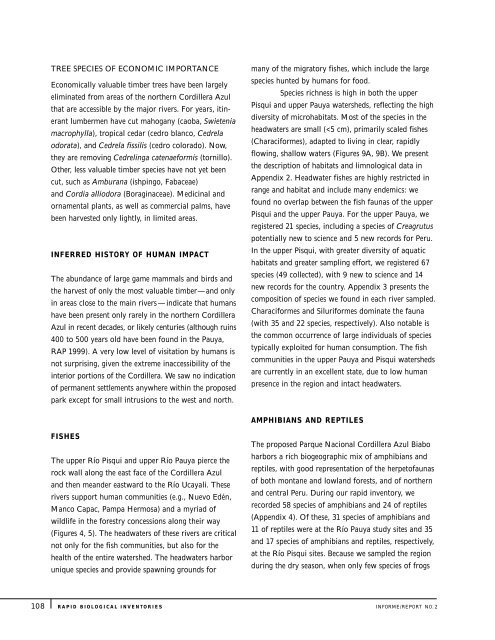RBI 02: Cordillera Azul - Espanol - The Field Museum
RBI 02: Cordillera Azul - Espanol - The Field Museum
RBI 02: Cordillera Azul - Espanol - The Field Museum
You also want an ePaper? Increase the reach of your titles
YUMPU automatically turns print PDFs into web optimized ePapers that Google loves.
108<br />
TREE SPECIES OF ECONOMIC IMPORTANCE<br />
Economically valuable timber trees have been largely<br />
eliminated from areas of the northern <strong>Cordillera</strong> <strong>Azul</strong><br />
that are accessible by the major rivers. For years, itinerant<br />
lumbermen have cut mahogany (caoba, Swietenia<br />
macrophylla), tropical cedar (cedro blanco, Cedrela<br />
odorata), and Cedrela fissilis (cedro colorado). Now,<br />
they are removing Cedrelinga catenaeformis (tornillo).<br />
Other, less valuable timber species have not yet been<br />
cut, such as Amburana (ishpingo, Fabaceae)<br />
and Cordia alliodora (Boraginaceae). Medicinal and<br />
ornamental plants, as well as commercial palms, have<br />
been harvested only lightly, in limited areas.<br />
INFERRED HISTORY OF HUMAN IMPACT<br />
<strong>The</strong> abundance of large game mammals and birds and<br />
the harvest of only the most valuable timber—and only<br />
in areas close to the main rivers—indicate that humans<br />
have been present only rarely in the northern <strong>Cordillera</strong><br />
<strong>Azul</strong> in recent decades, or likely centuries (although ruins<br />
400 to 500 years old have been found in the Pauya,<br />
RAP 1999). A very low level of visitation by humans is<br />
not surprising, given the extreme inaccessibility of the<br />
interior portions of the <strong>Cordillera</strong>. We saw no indication<br />
of permanent settlements anywhere within the proposed<br />
park except for small intrusions to the west and north.<br />
FISHES<br />
<strong>The</strong> upper Río Pisqui and upper Río Pauya pierce the<br />
rock wall along the east face of the <strong>Cordillera</strong> <strong>Azul</strong><br />
and then meander eastward to the Río Ucayali. <strong>The</strong>se<br />
rivers support human communities (e.g., Nuevo Edén,<br />
Manco Capac, Pampa Hermosa) and a myriad of<br />
wildlife in the forestry concessions along their way<br />
(Figures 4, 5). <strong>The</strong> headwaters of these rivers are critical<br />
not only for the fish communities, but also for the<br />
health of the entire watershed. <strong>The</strong> headwaters harbor<br />
unique species and provide spawning grounds for<br />
many of the migratory fishes, which include the large<br />
species hunted by humans for food.<br />
Species richness is high in both the upper<br />
Pisqui and upper Pauya watersheds, reflecting the high<br />
diversity of microhabitats. Most of the species in the<br />
headwaters are small (

















